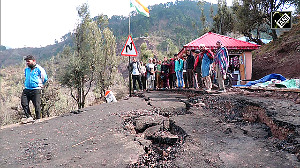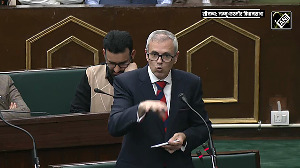When auto industry leader Maruti Udyog introduced a new air-conditioned version of its bestselling 800cc in January, analysts scoffed.
They said the new model, which cost an extra Rs 25,000, was too expensive for price-sensitive Indian customers.
Now they're eating their words. Less than six months later, the model already accounts for 30 per cent of M800 sales, and has a 3,500-customer waiting list -- way more than any other car on Indian roads.
It's the same story at rival Hyundai Motors. Today less than 10 per cent of all Santros hit the highway without air-conditioning or power steering.
The moral of the story: Indian customers are trading up and they are digging deeper into their pockets to do so. What's driving it: fatter pay cheques backed by cheap credit.
Guessing the size of the Indian middle class has been a favourite pastime for economists ever since the '80s. In those days, fancy numbers ranging between 50 million and 200 million were bandied about.
But the calculations went wrong because over 90 per cent of that giant figure had half the buying power of a supermarket check-out girl in western Europe or north America.
Now the numbers game is changing dramatically. The Indian consumer has arrived -- and he and she have cash to burn.
The National Council of Applied Economic Research reckons that in 1999-2000, 6.2 million households were car or jeep owning and therefore qualifed as 'affluent'.
That means that about 31 million consumers belong to four-wheeler owning households according to the NCAER's income demographic study, released last month.
That's a steep rise -- in fact, about six times -- from 1994-95 when only around 1 million households fell into the NCAER's 'affluent' category.
Step a few rungs down the ladder and the numbers become even more impressive. By 1999-00 more than 56.8 million households (284 million individuals) fell into NCAER's 'well-off' category.
NCAER's broad definition of 'well-off' includes households that own a range of consumer durables from two-wheelers to air-conditioners. The number of households categorised as 'well-off' has doubled since 1994-95.
Travel up the ladder briefly and it's the same story. The NCAER reckoned, in a separate study on the very rich, that in 2001 there were around 24,000 households where annual incomes exceeded Rs 50 lakh (Rs 5 million).
According to its calculations that figure will climb to around 54,000 in 2006. And about 320,000 people earned more than Rs 10 lakh (Rs 1 million) in 2001.
That will zoom to 700,000 in 2006. For statistical purposes these are based on 1995-96 price levels. Once you factor in the inflation that's taken place, the actual numbers could be two to three times higher.
Couple this sharp hike in the consumer base, with the increase in very low-cost consumer finance, and the result is almost explosive.
At LG India, sales of its 29-inch super-flat screen television, which costs a hefty Rs 36,000, have gone up from an average of 125 sets a month last year, to 1,000 this year.
Slightly down the line, sales of flat-screen TVs have soared from 5,500 during January-March 2002 to 80,000 during the same period this year.
At LG, flat-screen TVs are 40 per cent more expensive than non-flat-screen ones, according to C M Singh, national head for televisions. It's the same story at Samsung, where sales of flat screen TVs have climbed eight times in the last two years.
For the industry as a whole, flat-screen models comprised under 3 per cent of total sales two years ago, but are expected to go up to 10 per cent this year.
Or take a look at the cool rises that are taking place in the refrigerator market. Samsung is bullishly predicting that sales of its frost-free models will soar by 78 per cent this year.
For the industry as a whole, frost-free models are likely to grow at 13.7 per cent this year compared to just 5.1 per cent for conventional direct-cool models.
Says Rajeev Karwal, CEO of Electrolux Kelvinator: "From cars to DVDs and TVs, companies have added new features while reducing prices from 10 per cent to 60 per cent. There's a whole new value proposition, and customers are smart enough to make price-performance tradeoffs."
If people are upgrading it is largely because they can afford it -- even though it has become a bit of a tight squeeze since last year.
Between 1999 and 2003, according to Mercer Human Resource Consulting, which tracks salaries across the world, cash in hand (that's your salary minus the perks like club memberships and medical reimbursement) rose by a whopping 50 per cent for junior management across all industry segments in the country.
For middle management the rise was an equally impressive 45 per cent, and around 40 per cent for senior management.
Similar increases in income levels can be seen from the NCAER numbers. In 1989-90, just before economic reforms began, around 60 per cent of Indians earned below Rs 35,000 a year.
By 1998-99, only 40 per cent of Indians fell in this category. The top-most income class that NCAER's survey polled, accounted for a mere 1.4 per cent -- by 1998-99, this rose almost four times, to touch 5.7 per cent.
Since this rise in income, naturally, wasn't evenly distributed, there has been a huge hike in the consumer base in different cities.
According to the NCAER survey, in 1998-99, just under 40 per cent of Delhiites fell in the highest income category.
In Mumbai the number was around 30 per cent. But what's really surprising is that even Nagpur has 23 per cent of its population in this category.
A qualification must immediately be entered. It doesn't require a bulging wallet filled with credit cards to qualify as a high-income household under the NCAER categorisation.
The NCAER treats any household with an annual income of Rs 140,000 as belonging to the high income bracket. That's only about Rs 11,000 per month.
If you were to put that in dollar terms that's barely $220 monthly. Dollar comparisons are, of course, unfair and must be treated with caution, because Indians get more bang for their rupee.
Nevertheless, there's a new-found affluence that is showing in scores of different ways and it's percolating much further than ever before.
That's what Maruti Udyog discovered recently when it held loan melas in cities like Varanasi and Jaipur. In Varanasi, the Maruti-State Bank of India loan carnival generated 124 queries and 42 loans were sanctioned immediately.
Similarly, in Jaipur 114 loans were sanctioned. This is about equal to the business that Maruti did in a month in these cities earlier.
Incomes may still be low by international standards but the availability of cheaper consumer finance has turned large swathes of India into consumers.
NCAER statistician Shashi Brahmankar points out that the impact of consumer finance first began to be felt in 1999-00.
In that year cheaper finance added around a fourth to the growth in the demand for white goods. In 1999-00, demand for financed white goods rose 23.9 per cent while the overall market grew just 18.9 per cent.
In the rural markets the availability of cheap finance was an even bigger factor in growth.
While rural demand for white goods grew 22.4 per cent in 1999-00, the growth of financed white goods rose a phenomenal 39.6 per cent.
The arrival of cheaper finance has completely changed buying patterns. At one level, Indians can now pay in instalments for everything for automobiles to microwaves.
What's more, it has enabled them to upgrade and buy costlier products.
As a result of this, purchase patterns have changed significantly, and consumers are now buying higher quality goods.
While just 4.6 per cent of consumers bought what NCAER calls Category III goods like cars and colour TVs in 1985-86, by 1998-99, this rose to 10.1 per cent.
Similarly, in the automobile sector, for instance, sales in the entry-level Category A class (the Maruti 800) were overtaken in 1999-00 by those in the more expensive Category B which includes slightly bigger cars like the Zen and the Santro.
And last year, the fastest growth segment, albeit on a lower base, was the D segment which includes cars like the Skoda Octavia and the Toyota Corolla -- sales in this category rose from 990 in 2001 to 5,600 in 2002.
There's a change of buying patterns even for two-wheelers, which are aimed mainly at a less prosperous segment of the population.
Some have moved to bigger bikes like the 250cc Kinetic Aquila which costs Rs 125,000. Even Kinetic was slightly taken aback when 200 vehicles were driven out of the showroom in record time.
In fact, the arrival of the Indian consumer in larger numbers is dramatically visible in industries like two-wheelers.
Back in 1996-97 about 930,000 motorbikes were sold in India. That's zoomed to 3.7 million in 2002-03. Of course, the sudden rise in numbers can also be attributed to the fact that motorcycles have outdistanced scooters on the road.
Why are tightly-budgeted Indian customers suddenly trading upwards? One reason is because consumer financing means there may not be a big difference in the monthly instalments.
For instance, an entry-level conventional fridge costs Rs 8,000 while a frost-free costs around Rs 14,500.
However the monthly instalments on the cheaper model is around Rs 600. That's compared to Rs 900 for the more expensive fridge.
Says Pavan Bhargava, general manager home appliances, Samsung: " Customers don't mind the difference since it's not that large."
Adds Hyundai's president B V R Subbu: "The combination of excise duty cuts and the availability of cheap finance, have made it possible for a customer today to buy an Accent for the same EMI as he or she had to pay for a Santro earlier."
There are, of course, other factors that are bringing more expensive products within reach of the Indian consumer. There's been a dramatic reduction in the prices of most consumer durables, thanks largely to technological innovations.
Says Jogesh Sethi, national head, washing machines, LG India, "We offer a Micom chip in our semi-automatic washing machines, for instance, and this makes it quite similar in features to most automatic machines available from the competition." LG's Model 950 costs around Rs 9,000 and its price has fallen by about 5 per cent in the last one year.
But while marketers will rejoice about the booming markets, they shouldn't get carried away. Make no mistake, the Indian customer is still extremely value conscious.
That's why, for instance, brands like Cavinkare's 50 paise Chik shampoo sachets are making massive inroads and clobbering well-known brands from companies like Hindustan Lever. Chik's market share is today just 2 per cent lower than the market leader, Lever's ClinicPlus.
The ready-to-wear garments sector, consulting firm KSA Technopak's chief Arvind Singhal estimates, is around Rs 20,000 crore (Rs 200 billion) today, but the top brands like Color Plus have only captured about 10 per cent of this.
For instance, Cambridge, a Mumbai brand, retails shirts at Rs 200 and has a turnover of around Rs 150 crore (Rs 1.50 billion).
Says Singhal: "The lesson is clear -- customers are upgrading, but they want quality at a lower price."
Additional reporting: Nandini Lakshman






 © 2025
© 2025